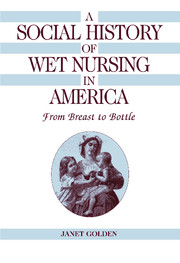Book contents
- Frontmatter
- Contents
- List of tables
- Acknowledgments
- List of abbreviations
- Introduction
- 1 Public discourse and private relations: Wet nursing in colonial America
- 2 The new motherhood and the new view of wet nurses, 1780–1865
- 3 Finding “just the right kind of woman”: The urban wet nurse marketplace, 1830–1900
- 4 “Victims of distressing circumstances”: The wet nurse labor force and the offspring of wet nurses, 1860–1910
- 5 Medical oversight and medical dilemmas: The physician and the wet nurse, 1870–1910
- 6 “Obliged to have wet nurses”: Relations in the private household, 1870–1925
- 7 “Therapeutic merchandise”: Human milk in the twentieth century
- Epilogue: From commodity to gift
- Index
- Cambridge History of Medicine
2 - The new motherhood and the new view of wet nurses, 1780–1865
Published online by Cambridge University Press: 06 July 2010
- Frontmatter
- Contents
- List of tables
- Acknowledgments
- List of abbreviations
- Introduction
- 1 Public discourse and private relations: Wet nursing in colonial America
- 2 The new motherhood and the new view of wet nurses, 1780–1865
- 3 Finding “just the right kind of woman”: The urban wet nurse marketplace, 1830–1900
- 4 “Victims of distressing circumstances”: The wet nurse labor force and the offspring of wet nurses, 1860–1910
- 5 Medical oversight and medical dilemmas: The physician and the wet nurse, 1870–1910
- 6 “Obliged to have wet nurses”: Relations in the private household, 1870–1925
- 7 “Therapeutic merchandise”: Human milk in the twentieth century
- Epilogue: From commodity to gift
- Index
- Cambridge History of Medicine
Summary
Thirty years after Elizabeth Drinker gave birth to her last child, another mother of eight published anonymously the first American book to deal exclusively with the raising of children: The Maternal Physician (1811). The author, Mary Palmer Tyler, sounding like a latter-day Cotton Mather, approached the question of maternal nursing in light of its moral value. Joining the chorus of those singing its praises, she urged mothers to “undergo every thing short of death or lasting disease” to nurse their babies. Still, like the medical authorities she cited, Tyler advised employing a wet nurse temporarily if the mother was unable to satisfy the hunger of her newborn or permanently if the mother could not nurse at all. Little had changed in the rhetoric of infant feeding or the rationale for employing wet nurses. The reality, however, was different.
Motherhood, as the discussions of Tyler and her contemporaries suggest, was being recontoured in the postrevolutionary era. The moral weight placed on maternal nursing grew heavier as women assumed even greater responsibility for child rearing and as child rearing was given greater emphasis in republican America. Overwhelming women's search for child-rearing advice was a flood of domestic treatises and popular medical guidebooks, all dealing with infant nurture. In this literature, the wet nurse appears in a new guise. As she crossed the threshold of her employer's home, bringing with her the taint of her environment and her flawed character, the wet nurse became a potential threat as well as a possible savior.
- Type
- Chapter
- Information
- A Social History of Wet Nursing in AmericaFrom Breast to Bottle, pp. 38 - 63Publisher: Cambridge University PressPrint publication year: 1996

